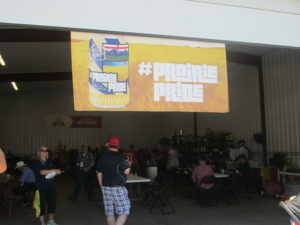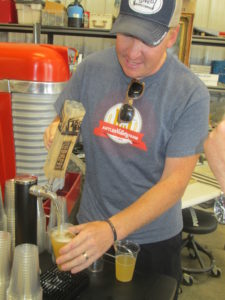In the wine world terroir refers to the impact that local environments have on the flavour and characteristics of wine. The nature of the soil, water and air where the grapes are grown affect the final shape of the wine. Terrior is less of a thing in beer, in part due to the global nature of the industry (we can get quality products from around the world) and in part that local influence generally expresses itself in terms of styles rather than the soil, etc.
If you think about it, lambics are a legitimate terroir beer, as they are profoundly shaped by the local micro-fauna. Some US breweries have been experimenting with terroir beer, using local ingredients and wild yeast to create unique product, but that particular approach has eluded Alberta. Until now.
In a random, unexpected and rather pleasant coincidence yesterday, I got to try a sample of Alberta’s first terroir beer. I was on my way home after a quick beer trip to hit some of the new Calgary breweries (more on that in a future post) and stopped by Red Shed Malting for a visit. When I arrived who was there but Graham Sherman of Tool Shed! With him was Wade McAllister, one of the owners of Antler Valley Farm, a nearby barley farm operation.
They told me that over at the farm that afternoon they were hosting tours (as part of a larger agriculturee event) and pouring the first offerings of a brand new, all-Alberta beer and invited me over. The beer is Prairie Pride and it is a beer three years in the making. It is made exclusively Alberta ingredients, right down to the yeast. The barley was grown at Antler Valley and malted at Red Shed. The hops were grown by Northern Girls Hops. There is some wheat from Rahr that Sherman indicates was sourced in Alberta. And the yeast – that is the real story.
About three years ago I remember Sherman telling me about a project he attempted to harvest some Alberta wild yeast. He fashioned a portable coolship and mounted it on his pick-up truck. He drove with the coolship filled with wort around a variety of farm fields and orchards, even leaving the truck for a few hours inside an old barn. The goal was to collect some yeast indigenous to Alberta for a beer experiment. I didn’t hear anything further about it so assumed the project didn’t work. I was wrong.
Instead he worked with the staff at the Olds College Brewmaster program. They isolated the various yeast and bacteria strains in the resulting beer, finding 13 different organisms. They then brewed a beer with each of the isolated organisms and evaluate the results. Sherman reports most ranged between unpalatable to undrinkable, but they found three that had potential. After further analysis they selected one that turned out to be an un-identified wild Saccromyces yeast – beer yeast!
 With the yeast in hand, the beer came together rather quickly. A simple recipe of 50% Antler Valley malt, 50% wheat and a low IBU dosing of Northern Girls goldings hops with an aim at a 4% to 4.5% alcohol beer. The yeast attenuated more than expected with the resulting beer ending up a bit over 5%.
With the yeast in hand, the beer came together rather quickly. A simple recipe of 50% Antler Valley malt, 50% wheat and a low IBU dosing of Northern Girls goldings hops with an aim at a 4% to 4.5% alcohol beer. The yeast attenuated more than expected with the resulting beer ending up a bit over 5%.
What was the beer like? It poured quite hazy with a light blond hue with orange highlights. Not much head to speak of. The aroma had a distinct and assertive orange character to it, along with some soft wheat graininess and an earthy, musty note. The sip had a noted orange-lemon citrus character, a soft sweet body and a slightly earthy accent. The finish was light and refreshing. It was recognizable as a farmhouse ale, with the expected musty, peppery yeast flavours.
What caught my attention the most was the orange-citrus character. That had to have come from the yeast, as no citrus or citrusy hop were used. That is fascinating. It gives the beer a unique flavour that makes it stand out.
Yesterday’s sampling was just a preview. The beer will be released to the general public within the next couple weeks and will be available on tap and in cans. It is worth picking up simply for the experience of sampling a true 100% Alberta beer.



July 14, 2017 at 10:00 AM
Wow! Great story.
Erica & I happened to be at Tool Shed the other day & were poured a tiny sample pff of the bright tank. I cannot wait to have it again (and really dive into a pint.)
July 15, 2017 at 2:23 PM
Alley Kat’s latest Back Alley Brew is also made with all-Alberta ingredients:
http://thebeerdiaries.tv/beer-review/alley-kat-bat-out-of-helles/
July 15, 2017 at 8:14 PM
Including yeast?
July 19, 2017 at 10:39 AM
Still going back to the same marketing schtick. You almost have to admire their persistence.
I’m curious how unique this strain of Saccromyces is.